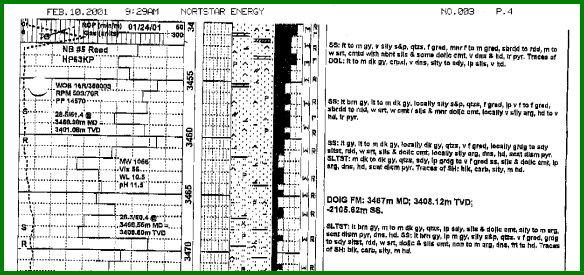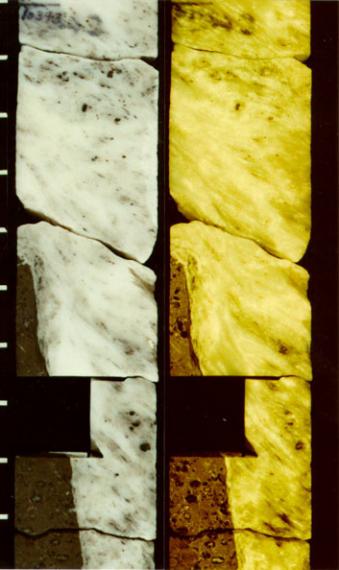|
 Calibrating Shale Volume to Sample Data
Calibrating Shale Volume to Sample Data
All
log analysis results need to be calibrated to any available "ground
truth", such as core data, sample descriptions, and other lab data.
Not all ground truth is quantitative, so a bit of judgment may be
required. Other forms of calibration data are very accurate, but the
results may apply to a tiny volume of rock. Upscaling to the log
analysis volume also requires some careful thought, and possible
some statistical smoothing of the fine scale data. Not all ground
truth is "true", due to cavings from uphole, lag time errors, depth
discrepancies, and other sampling anomalies.
One measure of a good log analysis is that results should
match ground truth reasonably well. In the case of shale
volume calculations, ground truth is usually rather sparse
and, if present, may be qualitative instead of quantitative.
 Sample
descriptions Sample
descriptions
Sample
descriptions are available on many wells. These will contain
a written description of the rock chips extracted from the
drilling mud. The description will include dominant mineralogy,
accessory minerals, cementing minerals, grain size or texture,
pore geometry, porosity estimate, and hydrocarbon shows.
Shale or clay, if present, will be mentioned, sometimes
with a volumetric estimate in percent. This work is done
by observation through a microscope. Samples can be re-logged
quantitatively after the initial review.
Samples
are well mixed by the mud circulation so these descriptions
include rock chips from a fairly large interval. In addition,
cavings from above the sampled interval will continue to
contaminate deeper samples. Samples also take a long time
to reach the surface, so their source depth is not perfectly
established. The time taken to reach the surface is called
the lag time. Lag time is calculated by comparing estimated
borehole volume with mud pump capacity and speed. It is
checked periodically by adding a chemical tracer to the
mud and measuring how long it takes to detect the tracer
back at the surface.
A
good wellsite geologist will correlate his description to
the shape of the drilling time log. Later, the sample depths
may be adjusted to the open hole logs, especially gamma
ray, resistivity and density logs. The geologist will also
eliminate most caving from the descriptions.

Typical Sample Description Log
Your
log analysis should show 80 to 100% shale where the geologist
shows “shale” or “mudtstone”. The
results should show 0 to 10% shale where the samples indicate
clean sandstone, limestone, dolomite, anhydrite, salt, or
mixtures of these minerals. Some shale should show on your
analysis where the samples contain shale or clay minerals.
A precise match is probably impossible due to the inherent
limitations of sample descriptions. At least the samples
will eliminate calculation of shale when in fact the zone
is a radioactive sandstone or dolomite.
 Core description
Core description
Core
descriptions have a better chance of being on depth with
the logs and can contain more detail than sample descriptions,
especially in thinly bedded formations. The core may demonstrate
more detail than the log resolution can follow, so you should
try matching to average data over a 2 or 3 foot interval.

Conventional Core Images
 PETROGRAPHY and THIN SECTION POINT COUNTS
PETROGRAPHY and THIN SECTION POINT COUNTS
Photo-micrographs
of sample chips or portions cut from cores can be interpreted
by a petrologist. Results are usually written descriptions
with considerable detail. Some can be quantitative. Thin
section photographs are made by first injecting a coloured
resin into the pores, then slicing and polishing. By passing
light through the thin section, particular minerals can
be identified by their colour and crystal structure. These
can be tabulated numerically and are called thin section
point counts.
Clays
and shales are easily identified as to quantity and type.
One petrological term can be confusing to log analysts.
The word “matrix” is used to describe fine-grained
minerals (often clays) surrounded and between larger mineral
grains. Log analysts use the term “matrix” to
mean all the minerals that make up the rock, excluding shale
and pore space.
 X-RAY DIFFRACTION DATA
X-RAY DIFFRACTION DATA
X-Ray diffraction data contains very detailed
information on the mineralogy of rock samples. The samples can be
very small, so obtaining a representative analysis requires a little
care. The data set can be scrutinized to sum up the total fraction
of clay minerals compared to the total of non- clay minerals.
|
X-RAY
DIFFRACTION DATA |
|
Depth (m) |
Quartz |
Pyrite |
Carbonate |
Albite |
Clay |
|
Top |
Bottom |
|
|
Calcite |
Dolomite |
|
Illite |
Kaolinite |
|
38.51 |
38.55 |
44.15 |
4.57 |
0.76 |
0.60 |
6.30 |
35.60 |
8.02 |
|
42.00 |
42.08 |
44.58 |
2.97 |
|
|
6.60 |
37.34 |
8.51 |
|
73.30 |
73.35 |
57.21 |
3.41 |
|
|
4.59 |
27.51 |
7.28 |
|
81.56 |
81.65 |
51.34 |
6.35 |
|
|
3.19 |
32.51 |
6.60 |
|
86.61 |
86.71 |
51.41 |
2.75 |
|
|
4.05 |
32.99 |
8.80 |
|
95.45 |
95.49 |
37.4 |
6.40 |
|
|
3.85 |
39.64 |
12.71 |
|
96.86 |
96.92 |
37.54 |
4.70 |
|
|
4.99 |
39.85 |
12.92 |
|
97.30 |
97.38 |
35.07 |
13.59 |
|
|
4.77 |
36.67 |
9.89 |
|
99.70 |
99.80 |
47.94 |
2.61 |
1.73 |
|
5.16 |
33.50 |
9.05 |
In
this example, clay volume of the dry samples ranges between 35 and
53%. Porosity and clay bound water need to be added back, based on
assumptions derived from log data in clean sands and pure shales, or
on compaction trend lines. If porosity and clay bound water are
approximately equal, the shale volume is equal to the clay volume in
the table, and no further manipulation is needed.
|

